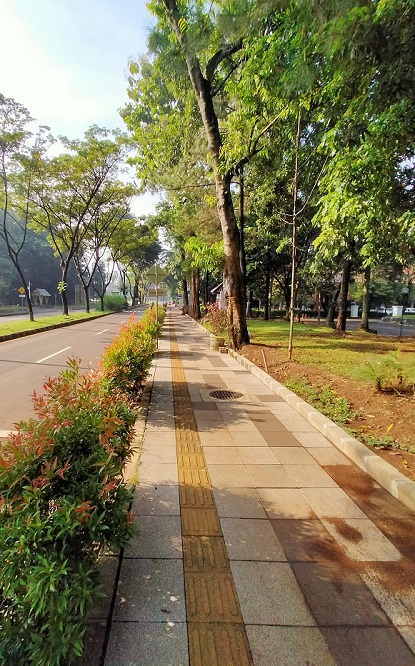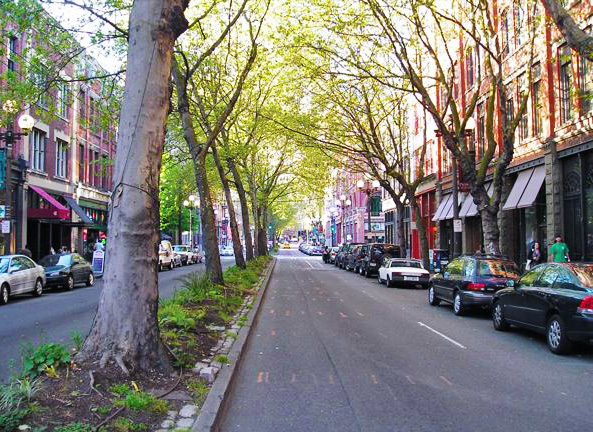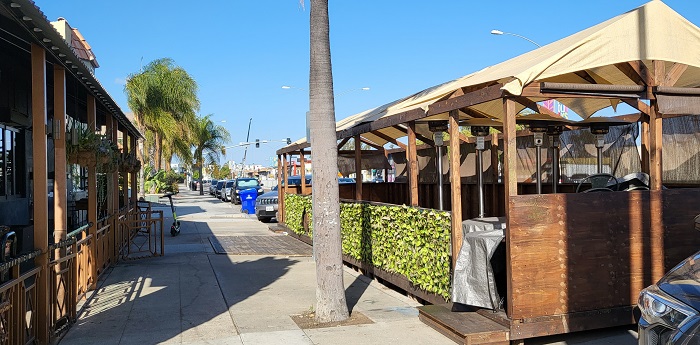Not just the side of the road anymore
It’s the exterior of a busy airport, with a close-up on the curb. A man announces over the public address system: “The red zone is for immediate loading and unloading of passengers only. There is no stopping in a white zone.”
The female PA announcer disagrees: “No, the white zone is for loading. Now, there is no stopping in a RED zone.”
The male PA announcer again: “The red zone has always been for loading.”
The female PA announcer responds: “Don’t you tell me which zone is for loading, and which zone is for unloading!”
Despite this classic scene from the movie “Airplane!,” management of curb zones is no joke. Today, curb management has gone beyond finding a good parking spot and a convenient way to deliver packages. Cities and transportation agencies must plan for areas to accommodate charging stations for electric vehicles, places to pick up and return bicycles, docking stations for rented scooters, space for Uber and Lyft services, a sharp increase in deliveries of groceries and meals, and even tables for outdoor dining.
As three transportation engineers and planners from Kittelson & Associates wrote, “Everybody wants a piece of the curb.” In their recent article, Alek Pochowski, Marc Butorac, and Jamie Henson wrote that curb usage is changing to meet the needs of new infrastructure (those charging stations and bikeshare rentals) and also due to changes brought on by the Covid-19 pandemic.
“In almost every urban area and town in the world, the curb is a scarce resource with many competing needs,” they wrote in the article titled “What COVID-19 Has Taught Us About Curbside Management.”
Some public agencies are beginning to think about and plan curb management “more holistically” to manage all the competing uses. “Everybody wants a piece of the curb: ride-hail services, buses, trucks, taxis, private shuttles, personal autos, pedestrians, bicyclists, micro-mobility sharing services, delivery services, restaurants, shops, offices, and residences,” they wrote. “Many are looking for a cheap and convenient place to store or charge their vehicle, bike, or scooter. Others want to pick up and drop-off passengers or freight as close to the front door of a business or residence as possible.”

Pulling back from the common emphasis on cars allows for a wider range of curb and sidewalk designs. (Source: NAMUBI)
The San Francisco Municipal Transportation Agency has recognized these new demands and challenges, and published a Curb Management Strategy in 2020. The plan defines the core functions of curbs and sets priorities for those uses based on the area (land use) of the city. It also describes design guidelines for different zones (White, Yellow, Green, and Blue).
The curb “is a seemingly mundane space, but it is the setting for an extremely diverse and dynamic set of activities fundamental to a vibrant and well-functioning city,” the SFMTA said. Despite significant changes to mobility options in the last 10 years, about 90 percent of San Francisco’s curb space is still reserved for vehicle parking.
“With so much space allocated to private car parking, the issue of curb access and management has become increasingly important,” according to the SFMTA report. “There are more mobility options now than ever before, so more people and goods are moving around without a private vehicle and without needing long-term on-street storage. This outdated curb allocation is increasingly at odds with San Francisco’s current transportation landscape.”
Curb management goes beyond allocating spaces. For the SFMTA, curb management encompasses and integrates other goals, such as improving traffic safety, supporting mobility, reducing greenhouse gas emissions, increasing public participation, promoting equity, and considering land use changes.
The National Association of City Transportation Officials has studied how changes to curb management can improve transit options and help local businesses. For example, a bus stop can deliver hundreds of riders per day, while a metered parking spot can serve only 15 vehicles.
A transit-friendly curb management strategy includes better bus lanes, right-turn pockets so cars do not block buses, and moving the loading and parking areas off the main streets, according to the Association’s white paper titled “Curb Appeal: Curbside Management Strategies for Improving Transit Reliability.”
“Now, cities across North America are recognizing the value of their curbsides as flexible zones,” the Association said. “To make corridor-level changes possible, leading cities are adopting and acting on policies that prioritize reliable transit and safe bicycling infrastructure first, followed by other important uses of the curb like deliveries, passenger pick-ups, green stormwater infrastructure, and small public spaces – as well as managed parking.”

Redesigning sidewalks and curbs can give cities the opportunity to beautify certain areas while also placing emphasis on pedestrians and business needs. (Source: NACTO)
Dynamic pricing plans and new software systems are also emerging as part of curb management strategies. New software platforms can capture street signage and usage to help cities visualize their curb network, according to a recent article in The Guardian, “The hidden climate costs of America’s free parking spaces.” Two software systems cited in the article, CurbIQ and Coord, can help cities to understand the best ways to repurpose curb areas or even allow delivery drivers to schedule usage through an app.
Free parking on the street may seem like a birthright, but there are implications for greenhouse gas emissions, public transit opportunities, and new uses like pocket parks and outdoor dining.
The Guardian article quoted UCLA Professor Donald Shoup: “The curb lane is some of the most valuable land on Earth. I think that’s our biggest mistake, to take some of the most valuable land on Earth and give it away, free, to cars.” (Read more about Professor Shoup in this Bloomberg article titled “Free Parking Is Killing Cities.”)
With changes to transportation options and more demands for curb space, IMS expects to see a growing number of RFPs seeking professional engineering and planning services for curb management. IMS covers current RFPs on a daily basis and tracks future projects through Advance Notices for its architectural, engineering, and consulting clients. Already, IMS has seen several recent cases where agencies are seeking consulting services for curb management:
* The City of Buffalo, N.Y., released an RFP in November 2021 to develop a curb management plan to address how curbs and public right-of-way spaces can be allocated to accommodate multiple users. The project included a preliminary design for a flexible smart street framework to adapt to changing conditions (IMS 598521).

Many restaurants reclaimed curbside parking spots for outdoor dining areas in the wake of COVID.
* In Michigan, the Ann Arbor Downtown Development Authority released an RFP in October 2021 to provide research, analysis, and recommendations for a Downtown Curb Management Assessment and Toolkit to manage/balance competing demands for curb space (IMS 595041).
* The City of Bozeman, Mont., issued an RFP in October 2021 to assess and provide recommendations and ongoing advisory services regarding the City’s parking system and curb management strategy (IMS 594548).
* The City of Bellevue, Wash., released an RFQ in August 2021 to prepare a Curb Management Plan to help refresh curbside management practices and procedures, update curb-related policies, and provide a technical analysis for launching a more robust curb management program (IMS 585550).
* The City of Boulder issued an RFP in August 2021 for consultants to lead the policy and program development for curbside management in the city, which will meet the goals of the Access Management and Parking Strategy, Transportation Master Plan, and other city initiatives (IMS 585140).
* The Southern California Association of Governments released an RFP in February 2021 for a study to review of some of the most congested and complicated curb space locations within the six-county region. Study goals included: 1) reducing vehicle miles traveled/vehicle hours traveled and greenhouse gas emissions; 2) reducing congestion; and 3) promoting a balanced transportation system by better understanding first- and last-mile relationships between transportation network companies (IMS 555578).
Curb management can open opportunities for cities and transportation agencies. There are opportunities for bike sharing and faster transit, outdoor dining and shopping, more efficient deliveries, reducing greenhouse gas emissions, and supporting local businesses. It’s a process that requires agencies to understand their current curb landscape, determine priority uses for each zone, and establish goals for transit and commerce. That planning effort will lead to a curb management strategy and designs that can help cities make the most of this valuable real estate.

